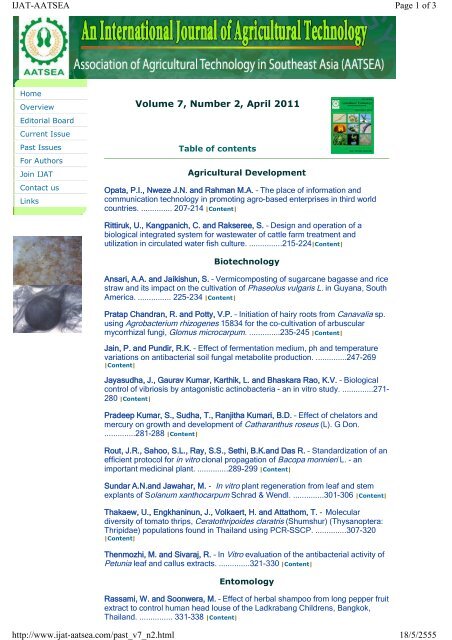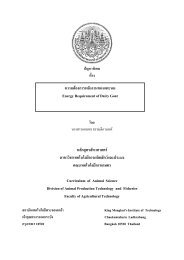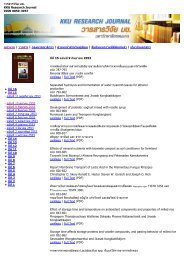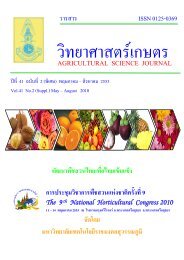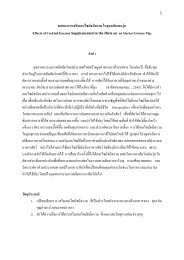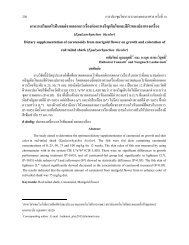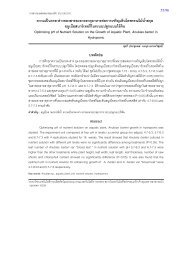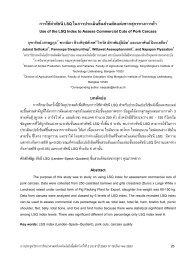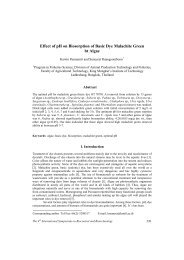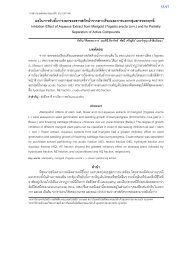Volume 7, Number 2, April 2011 Page 1 of 3 IJAT-AATSEA 18/5 ...
Volume 7, Number 2, April 2011 Page 1 of 3 IJAT-AATSEA 18/5 ...
Volume 7, Number 2, April 2011 Page 1 of 3 IJAT-AATSEA 18/5 ...
Create successful ePaper yourself
Turn your PDF publications into a flip-book with our unique Google optimized e-Paper software.
<strong>IJAT</strong>-<strong>AATSEA</strong><br />
Home<br />
Overview<br />
Editorial Board<br />
Current Issue<br />
Past Issues<br />
For Authors<br />
Join <strong>IJAT</strong><br />
Contact us<br />
Links<br />
http://www.ijat-aatsea.com/past_v7_n2.html<br />
<strong>Volume</strong> 7, <strong>Number</strong> 2, <strong>April</strong> <strong>2011</strong><br />
Table <strong>of</strong> contents<br />
Agricultural Development<br />
Opata, P.I., Nweze J.N. and Rahman M.A. – The place <strong>of</strong> information and<br />
communication technology in promoting agro-based enterprises in third world<br />
countries. .............. 207-214 |Content|<br />
Rittiruk, U., Kangpanich, C. and Rakseree, S. – Design and operation <strong>of</strong> a<br />
biological integrated system for wastewater <strong>of</strong> cattle farm treatment and<br />
utilization in circulated water fish culture. ............... 215 -224|Content|<br />
Biotechnology<br />
Ansari, A.A. and Jaikishun, S. – Vermicomposting <strong>of</strong> sugarcane bagasse and rice<br />
straw and its impact on the cultivation <strong>of</strong> Phaseolus vulgaris L. in Guyana, South<br />
America. ............... 225-234 |Content|<br />
Pratap Chandran, R. and Potty, V.P. – Initiation <strong>of</strong> hairy roots from Canavalia sp.<br />
using Agrobacterium rhizogenes 15834 for the co-cultivation <strong>of</strong> arbuscular<br />
mycorrhizal fungi, Glomus microcarpum. ..............235-245 |Content|<br />
Jain, P. and Pundir, R.K. – Effect <strong>of</strong> fermentation medium, ph and temperature<br />
variations on antibacterial soil fungal metabolite production. ..............247-269<br />
|Content|<br />
Jayasudha, J., Gaurav Kumar, Karthik, L. and Bhaskara Rao, K.V. – Biological<br />
control <strong>of</strong> vibriosis by antagonistic actinobacteria - an in vitro study. ..............271-<br />
280 |Content|<br />
Pradeep Kumar, S., Sudha, T., Ranjitha Kumari, B.D. – Effect <strong>of</strong> chelators and<br />
mercury on growth and development <strong>of</strong> Catharanthus roseus (L). G Don.<br />
..............281-288 |Content|<br />
Rout, J.R., Sahoo, S.L., Ray, S.S., Sethi, B.K.and Das R. – Standardization <strong>of</strong> an<br />
efficient protocol for in vitro clonal propagation <strong>of</strong> Bacopa monnieri L. - an<br />
important medicinal plant. ..............289-299 |Content|<br />
Sundar A.N.and Jawahar, M. - In vitro plant regeneration from leaf and stem<br />
explants <strong>of</strong> Solanum xanthocarpum Schrad & Wendl. ..............301-306 |Content|<br />
Thakaew, U., Engkhaninun, J., Volkaert, H. and Attathom, T. - Molecular<br />
diversity <strong>of</strong> tomato thrips, Ceratothripoides claratris (Shumshur) (Thysanoptera:<br />
Thripidae) populations found in Thailand using PCR-SSCP. ..............307-320<br />
|Content|<br />
Thenmozhi, M. and Sivaraj, R. – In Vitro evaluation <strong>of</strong> the antibacterial activity <strong>of</strong><br />
Petunia leaf and callus extracts. ..............321-330 |Content|<br />
Entomology<br />
Rassami, W. and Soonwera, M. – Effect <strong>of</strong> herbal shampoo from long pepper fruit<br />
extract to control human head louse <strong>of</strong> the Ladkrabang Childrens, Bangkok,<br />
Thailand. ............... 331-338 |Content|<br />
<strong>Page</strong> 1 <strong>of</strong> 3<br />
<strong>18</strong>/5/2555
Journal <strong>of</strong> Agricultural Technology <strong>2011</strong> Vol. 7(2): 331-338<br />
Journal <strong>of</strong> Agricultural Available Technology online http://www.ijat-aatsea.com<br />
<strong>2011</strong>, Vol.7(2): 331-338<br />
ISSN 1686-9141<br />
Effect <strong>of</strong> herbal shampoo from long pepper fruit extract to<br />
control human head louse <strong>of</strong> the Ladkrabang Childrens,<br />
Bangkok, Thailand.<br />
Rassami, W. * and Soonwera, M.<br />
School <strong>of</strong> Graduate Studies, King Mongkut’s Institute <strong>of</strong> Technology Ladkrabang, Bangkok<br />
Faculty <strong>of</strong> Agricultural Technology, King Mongkut’s Institute <strong>of</strong> Technology Ladkrabang,<br />
Bangkok.<br />
Rassami, W. and Soonwera, M. (<strong>2011</strong>). Effect <strong>of</strong> herbal shampoo from long pepper fruit extract<br />
to control human head louse <strong>of</strong> the Ladkrabang Childrens, Bangkok, Thailand. Journal <strong>of</strong><br />
Agricultural Technology 7(2): 331-338.<br />
Study on 2 formulation <strong>of</strong> herbal shampoo from long pepper fruit (Piper retr<strong>of</strong>ractum) extracts,<br />
formulation 1 (10 %concentrations <strong>of</strong> long pepper fruit extracts) and formulation 2 (3%<br />
concentrations <strong>of</strong> long pepper fruit extracts) were tested against human head louse (Pediculus<br />
capitis) <strong>of</strong> sixty heavity lice-infested female childrens at Ladkrabang, Bangkok, Thailand.<br />
Twenty milliliter <strong>of</strong> the herbal shampoo was thoroughly mixed with completely wet hair<br />
basically combed with fine comb. Both herbal shampoo showed insecticidal effect on the lice<br />
<strong>of</strong> 99 – 100 % mortality occurred at 5 min and 90 – 100 % <strong>of</strong> human head lice free childrens<br />
occurred at 28 days. The both herbal shampoo proved to be highly effective against all stage <strong>of</strong><br />
human head lice were considereds safe to children, no side effect after application.<br />
Key words: Pediculus capitis, herbal shampoo<br />
Introduction<br />
Human head louse (Pediculus capitis De Geer : Pediculidae :<br />
Phthiraptera) is the major insect as ectoparasite <strong>of</strong> human and feed on human<br />
blood only, very small, wingless and the size <strong>of</strong> 2.0 – 4.0 mm with sucking<br />
mouth part. (Fig. 1) The life cycle requires <strong>18</strong>.0 – 27.0 days, with the adults<br />
living up to 35.0 – 40.0 days (Soonweera, 2005; Soonwera and Wangspha,<br />
2007; Wikipedia, 2009) Lice are cosmopolitan parasite found in all areas <strong>of</strong> the<br />
world and a socio-economic problem. Each year in USA and danada there are<br />
6 – 20 million case <strong>of</strong> human head louse, as many as 6 – 12 million people<br />
worldwide are newly infested with human head lice each year. Human head lice<br />
are not known to transmit diseases from person-to-person, but they are<br />
* Corresponding author: W. Rassami; e-mail: wrassamirbru@gmail.com<br />
331
annoying insects due to their obligatory feeding habits on human blood several<br />
times a day, and many cause itching, irritation, loss <strong>of</strong> blood and loss <strong>of</strong> sleep<br />
(Abdel-Ghaffar and Semmler, 2007; Soonweera and Wangspha, 2007)<br />
332<br />
a b c<br />
Fig. 1. Human head louse (Pediculus capitis); Egg (a), Nymph (b) and Adult (c).<br />
Lice infestation are very common, preschool and elementary age children,<br />
8 to 10 years <strong>of</strong> age infested most <strong>of</strong>ten and female childrens are infested more<br />
than male childrens. Lice are spread by direct contact, walking from one hair or<br />
head to another or by infested articles, that has recently been contacted with an<br />
infested articles, such as hats, wings, combs, hair bushes, hair ribbons, pillow,<br />
that has recently been contacted with an infested person (Soonwera, 2005)<br />
Chemical treatments with pesticides for lice control are very dangerous<br />
for childrens, they have less under developed detoxification mechanisms, they<br />
are more susceptible and sensitive to the toxic effect <strong>of</strong> pesticides such as skin<br />
irritation, headaches, burning sensations, and hyperactivity. Malathion has also<br />
been found to disrupt the immune system, caboryl is a potential human<br />
carcinogen (any substance that produce cancer) and synthetic pyrethroids (e.g.<br />
permathrin, phenothrin) are the potential human leukaemia and lymphoid<br />
cancer. Pollack et al (1999); Baily and Prociv (2000) and Burkhart (2004) also<br />
reported that some head lice become resistant to pyrethroid insecticides and<br />
some pesticides.<br />
In rural and urban areas <strong>of</strong> Thailand, childrens are treated pediculosis<br />
with organophosphate and synthetic pyrethroid insecticides. The awareness <strong>of</strong><br />
the toxic effects <strong>of</strong> pesticides on human health is increasing rapidly. The search<br />
for safe and effective product, which do not rely on the application <strong>of</strong><br />
dangerous insecticides to the childrens, is demanded urgently. The natural<br />
product from herbs is safe and effective alternative to control lice <strong>of</strong> childrens.<br />
Abde-Ghaffar and Semmler (2007), Soonwera and Wangsapha (2007), Rassami<br />
and Soonwera (2009) reported that neem seed extract shampoo, herbal<br />
shampoo from Zingiber <strong>of</strong>ficinale (Zingiberaceae) and herbal shampoo from
Journal <strong>of</strong> Agricultural Technology <strong>2011</strong>, Vol.7(2): 331-338<br />
Angelica siamensis (Umbelliferae) proved to be highly effective against all<br />
stage <strong>of</strong> human head lice and no side effect <strong>of</strong> children, after treated.<br />
This study was investigated herbal shampoo from long pepper fruit<br />
extracts to control human head lice <strong>of</strong> Ladkrabang childrens, Bangkok,<br />
Thailand.<br />
Materials and methods<br />
Preparation <strong>of</strong> herbal shampoo<br />
The herbal shampoo formulation 1 was prepared from 10 %Piper<br />
retr<strong>of</strong>ractum fruit extracts, 10% sodium laureth sulfate and 80 %distilled water,<br />
the herbal shampoo formulation 2 was prepared from 3% Piper retr<strong>of</strong>ratum fruit<br />
extracts, 10 %sodium laureth sulfate and 87 %distilled water and base shampoo<br />
(Control) was prepared from 10% sodium laureth sulfate and 90% distilled<br />
water<br />
Preparation <strong>of</strong> human head lice and laboratory experiment<br />
Female childrens <strong>of</strong> Ladkrabang area, Bangkok were screened for<br />
pediculosis. After a preliminary thorough examination <strong>of</strong> the skin <strong>of</strong> the scalp,<br />
the neck and behind the ears, a total number <strong>of</strong> 90 naturally infected female<br />
childrens, a fine comb was used to thoroughly comb the hair <strong>of</strong> female<br />
childrens and collected adult <strong>of</strong> human head lice for testing the insecticidal<br />
effect <strong>of</strong> both herbal shampoo by topical application method in laboratory<br />
condition, into 3 treatment groups as follows:-<br />
Treatment 1 : Herbal shampoo formulation 1<br />
Treatment 2 : Herbal shampoo formulation 2<br />
Treatment 3 : Base shampoo (Control)<br />
There were 10 lice per experimental unit and 10 experimental unit per 1<br />
treatment in a completely Randomized Design (CRD). The mortality <strong>of</strong> lice per<br />
experimental unit was calculated and recorded after treated 5, 10, 20 and 30<br />
sec. Statistical analysis <strong>of</strong> experimental data was performed using probit<br />
analysis to find out the LT50 (Lethal Time). The data was analysed by<br />
completely randomized design and the means were separated using Duncan’s<br />
Multiple Range Test (DMRT), test at P = 0.05. This experiment was done on<br />
two reexperiment.<br />
333
Experiment <strong>of</strong> herbal shampoo against human head lice <strong>of</strong> naturally infected<br />
female childrens<br />
90 female childrens (heavy infestation with lice) from Ladkrabang area,<br />
Bangkok, age 8 – 10 years were selected to participate in the experiment. 90 :<br />
female childrens were randomly separated into 3 treatment groups as follows:-<br />
Treatment 1 : treatment with herbal shampoo formulation 1 (30 female childrens)<br />
Treatment 2 : treatment with herbal shampoo formulation 2 (30 female childrens)<br />
Treatment 3 : base shampoo (Control) (30 female childrens)<br />
For application completely wet hair was thoroughly mixed, according to<br />
the length <strong>of</strong> the hair, with 20 ml <strong>of</strong> herbal shampoo and base shampoo<br />
(Control). The shampoo remained mixed with the hair for 5 min. and the<br />
shampoo was washed out with tap water (Fig. 2). The mortality <strong>of</strong> 7, 14 and 21<br />
days after the initial treatment. The data was analysed by completely<br />
randomized and the means were separated using Duncan’s Multiple Range Test<br />
(DMRT), at P = 0.05.<br />
Results<br />
334<br />
Fig. 2. Female childrens during application <strong>of</strong> the herbal shampoo.<br />
The effect <strong>of</strong> herbal shampoo on mortality <strong>of</strong> human head lice in Laboratory<br />
condition<br />
The effect <strong>of</strong> herbal shampoo formulation 1, herbal shampoo formulation<br />
2 and base shampoo (Control) on mortality <strong>of</strong> human head lice in laboratory,<br />
the mortality and LT50 value revealed that herbal shampoo formulation 1 and<br />
formulation 2 proved the most effective against human head lice <strong>of</strong> 100%<br />
mortality occurred at 30 sec. and LT50 value <strong>of</strong> 11.37 and 16.70 sec.,
Journal <strong>of</strong> Agricultural Technology <strong>2011</strong>, Vol.7(2): 331-338<br />
respectively and base shampoo (Control) showed <strong>of</strong> 80% mortality occurred at<br />
30 sec. and LT50 value <strong>of</strong> 25.34 sec. as shown in Table 1 and Fig 3.<br />
Experiment <strong>of</strong> herbal shampoo against human head lice <strong>of</strong> naturally infected<br />
female childrens.<br />
The effect <strong>of</strong> herbal shampoo formulation 1, formulation 2 and base<br />
shampoo (control) on mortality <strong>of</strong> lice <strong>of</strong> a heavy infestation with lice in 30<br />
female childrens per treatment. After application herbal shampoo formulation 1<br />
and formulation 2 shampoo for 5 min. 100 and 99 %<strong>of</strong> the collected different<br />
stage <strong>of</strong> lice were dead, less than 1 %was still alive and slight movement and<br />
base shampoo (Control) showed <strong>of</strong> 47.22% mortality.<br />
In the second, third and fourth experiment, after application herbal<br />
shampoo formulation 1 and formulation 2 for 5 min. 100 %<strong>of</strong> the collected lice<br />
was dead and base shampoo (Control) showed <strong>of</strong> 43.43, 36.37 and 34.23%<br />
mortality, respectively as shown in Table 2 and Fig.4<br />
The percentage <strong>of</strong> human head lice – free childrens after application<br />
herbal shampoo formulation 1 at 1 st , 2 nd , 3 rd and 4 th experiment showed <strong>of</strong> 40,<br />
50, 80 and 90% human head lice – free childrens, respectively. Effect <strong>of</strong> base<br />
shampoo (Control) on human head lice –free childrens showed <strong>of</strong> 20, 25, 55<br />
and 60.0 % after treated at 1 st , 2 nd , 3 rd and 4 th experiment, respectively, as<br />
shown in Table 3 and Fig.5<br />
Table 1. Effects <strong>of</strong> herbal shampoo on mortality <strong>of</strong> human head lice occurred at<br />
5, 10, 20 and 30 sec. by Topical application method in the laboratory condition.<br />
Treatments % mortality/Time(sec.) LT50 (sec.)<br />
5 10 20 30<br />
Herbal shampoo formulation 1 20.0 a 1 45.0 a 85.0 a 100 a 11.37<br />
Herbal shampoo formulation 2 16.0 a 32.0 b 70.0 b 100 a 16.70<br />
Base shampoo (Control) 0 b 0 c 40.0 c 80.0 b 25.34<br />
CV(%) 154.21 45.63 <strong>18</strong>.29 5.54<br />
1 means that data within the some column followed by the same letter are not significantly<br />
different by DMRT (P=0.05).<br />
335
336<br />
% mortality<br />
Fig. 3. The mortality <strong>of</strong> human head lice after treated herbal shampoo formulation 1,<br />
herbal shampoo formulation 2 and base shampoo (Control).<br />
Table 2. Effects <strong>of</strong> herbal shampoo on mortality <strong>of</strong> human head lice <strong>of</strong><br />
naturally infected female childrens, 5 min. after treated on 1 st , 2 nd , 3 rd and 4 th<br />
experiment.<br />
Treatments % mortality/experiment<br />
1 st 2 nd 3 rd 4 th<br />
Herbal shampoo formulation 1 100 a 1 100 a 100 a 100 a<br />
Herbal shampoo formulation 2 99.0 a 100 b 100 b 100 a<br />
Base shampoo (Control) 47.22 b 43.63 c 37.37 c 34.23 b<br />
CV(%) 20.23 11.56 12.37 12.67<br />
1 means that data within the some column followed by the same letter are not significantly<br />
different by DMRT (P=0.05)<br />
% mortality<br />
100<br />
50<br />
0<br />
100<br />
80<br />
60<br />
40<br />
20<br />
0<br />
5 10 20 30<br />
Time (sec.)<br />
1st 2nd 3rd 4th<br />
experment<br />
Herbal shampoo<br />
formulation 1<br />
Herbal shampoo<br />
formulation 2<br />
Base shampoo<br />
(Control)<br />
Herbal shampoo<br />
formulation 1<br />
Herbal shampoo<br />
formulation 2<br />
Base shampoo<br />
(Control)<br />
Fig. 4. The mortality <strong>of</strong> human head lice after treated herbal shampoo formulation 1,<br />
herbal shampoo formulation 2 and base shampoo (Control) <strong>of</strong> naturally infected<br />
female childrens.
Journal <strong>of</strong> Agricultural Technology <strong>2011</strong>, Vol.7(2): 331-338<br />
Table 3. Effects <strong>of</strong> herbal shampoo on human head lice – free childrens, 5 min.<br />
after application <strong>of</strong> herbal shampoo, on 1 st , 2 nd , 3 rd and 4 th experiment.<br />
Treatments % human head lice – free childrens/experiment<br />
1 st 2 nd 3 rd 4 th<br />
Herbal shampoo formulation 1 45.0 a 1 80.0 a 90.0 a 100 a<br />
Herbal shampoo formulation 2 40.0 a 50.0 b 80.0 b 90.0 a<br />
Base shampoo (Control) 20.0 b 25.0 c 55.0 c 60.0 b<br />
CV(%) 30.22 20.16 10.52 9.23<br />
1 means that data within the some column followed by the same letter are not significantly<br />
different by DMRT (P=0.05)<br />
Discussion<br />
% Human head lice-free<br />
childrens<br />
100<br />
80<br />
60<br />
40<br />
20<br />
0<br />
1st 2nd 3rd 4th<br />
experiment<br />
Herbal shampoo<br />
formulation 1<br />
Herbal shampoo<br />
formulation 2<br />
Base shampoo<br />
(Control)<br />
Fig. 5. Human head lice – free chidrens after treated herbal shampo<strong>of</strong>ormulation 1,<br />
herbal shampoo formulation 2 and base shampoo (Control).<br />
In this research, the herbal shampoo formulation 1 and formulation 2<br />
proved to be highly effective against nymph and adult <strong>of</strong> human head lice more<br />
than base shampoo (control). As a result, Suppasan (2005) reported that herbal<br />
shampoo from piperaceae plants extract showed that 98.0% <strong>of</strong> human head lice<br />
– free childrens after treated <strong>of</strong> herbal shampoo. Both herbal shampoo are<br />
highly effective against nymph and adult <strong>of</strong> human head lice in naturally<br />
infected childrens, and safe to childrens. After application <strong>of</strong> both herbal<br />
shampoo did not show any negative side effect such as erythema, skin irritation<br />
and burring sensation, for a safe and effective treatment <strong>of</strong> pediculosis, the<br />
herbal shampoo should be applied for 5 min. once a week.<br />
337
Acknowledgements<br />
This research has been financially supported by Faculty <strong>of</strong> Agricultural Technology,<br />
King Mongkut’s Institute <strong>of</strong> Technology Ladkrabang. We also thanks the female childrens <strong>of</strong><br />
Ladkrabang district, Bangkok. for participation in experiment.<br />
References<br />
Abdel-Ghaffar, F. and Semmler, M. (2007) Efficacy <strong>of</strong> neem seed extract shampoo on head<br />
lice <strong>of</strong> naturally infected human in Egypt. Parasitol. Res. 100: 329–332.<br />
Baily, A. M., Prociv, P. (2000) Persistent head lice following multiple treatments : evidence or<br />
insecticide resistance in Pediculus humanus capitis. Australas J. Dermatal 41: 250–254.<br />
Burkhart, C. G. (2004) Relationship <strong>of</strong> treatment resistant head lice to the safety and efficacy<br />
<strong>of</strong> pediculicides. Mayo Chlin. Proc. 79: 661–666.<br />
Pollack, R.J., Kijzewski, A., Armstrong, P., Hahn, C. Wolfe, N., Rahman, H.A. (1999). Differentia<br />
permethrin susceptibility <strong>of</strong> head lice sample in US and Borneo. Arch. Pediatr. Adolese. Med.<br />
153: 969–973.<br />
Rassami, W. and Soonwera, M. (2009) Some effect from medicinal plant for controlling human<br />
head louse : Case study on Wat Ratchakosa school, Ladkrabang, Bangkok. p364–369 in<br />
Rambhai Barni Rahabhat University Conference, Chanthaburi, Dec, 20 –21, 2009.<br />
Soonwera, M. (2005). Efficacy <strong>of</strong> zingiberaceae plant extracts an zingiberaceae shampoo for<br />
controlling head lice. King Mongkut’s Agricultural Journal. 23: 52–57.<br />
Soonweera, M. and W. Wangspha . (2007). Effectiveness <strong>of</strong> Botanical shampoo to control human<br />
head louse : case study on school girls at Wat-Podsattha school and Wat- Sutthaod school,<br />
p331 – 334 in International conference on Integration <strong>of</strong> science & Technology for sustainable<br />
development, KMITL, Bangkok, <strong>April</strong>, 26–27, 2007.<br />
Suppasan, S. (2005). Control <strong>of</strong> human head louse (Pediculus capitis De Geer.) by some medicinal<br />
plant extracts. Master <strong>of</strong> Science in Plant Pest Management Technology Thesis, King<br />
Mongkut’s Institute <strong>of</strong> Technology Ladkrabang, Bangkok.<br />
Wikipedia. (2009). Head louse. [Online]. Available : http://en.wikipedia.org. (20/09/2009)<br />
338<br />
(Received 1 <strong>April</strong> 2010; accepted 4 March <strong>2011</strong>)


